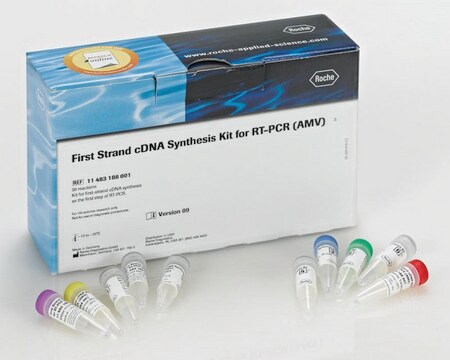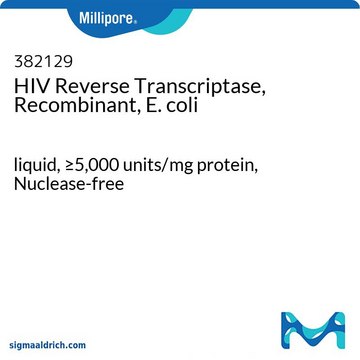M1302
M-MLV Reverse Transcriptase
Moloney Murine Leukemia Virus enzyme & buffer for cDNA synthesis
Sinonimo/i:
Moloney Murine Leukemia Virus Reverse Transcriptase
About This Item
Prodotti consigliati
Origine biologica
Porcine intestinal mucosa
Ricombinante
expressed in E. coli
Stato
liquid
impiego
sufficient for 200 reactions
sufficient for 250 reactions
Caratteristiche
dNTPs included: no
hotstart: no
Concentrazione
200 units/μL
tecniche
RT-PCR: suitable
Colore
colorless
input
purified RNA
Condizioni di spedizione
wet ice
Temperatura di conservazione
−20°C
Descrizione generale
Applicazioni
- for the preparation of cDNA libraries or for first strand cDNA synthesis
- for use in a 2-step RT-PCR assay
- in quantitative realtime-polymerase chain reaction (RT-qPCR)
- in reverse transcription
Caratteristiche e vantaggi
- Thermostable reverse transcriptase active at 37 °C.
- Can be used to generate first strand cDNA of up to 7 kb.
Confezionamento
Definizione di unità
Nota sulla preparazione
Note legali
Inibitore
Prodotti correlati
Avvertenze
Danger
Indicazioni di pericolo
Consigli di prudenza
Classi di pericolo
Resp. Sens. 1
Codice della classe di stoccaggio
12 - Non Combustible Liquids
Classe di pericolosità dell'acqua (WGK)
WGK 3
Punto d’infiammabilità (°F)
Not applicable
Punto d’infiammabilità (°C)
Not applicable
Dispositivi di protezione individuale
Eyeshields, Gloves, multi-purpose combination respirator cartridge (US)
Scegli una delle versioni più recenti:
Possiedi già questo prodotto?
I documenti relativi ai prodotti acquistati recentemente sono disponibili nell’Archivio dei documenti.
I clienti hanno visto anche
Articoli
The introduction of small interfering RNAs (siRNAs) into cultured cells provides a fast and efficient means of knocking down gene expression and has allowed siRNAs to quickly become a ubiquitous tool in molecular biology.
Introduction of small interfering RNAs (siRNAs) into cultured cells provides a fast and efficient means of knocking down gene expression and has allowed siRNAs to quickly become a ubiquitous tool in molecular biology.
One approach to the analysis of gene expression is to measure the concentration of mRNA of a gene. There are several challenges to such analyses, such as the differences in half life between different transcripts, the temporal patterns of transcription and the lack of correlation between mRNA and protein.
Il team dei nostri ricercatori vanta grande esperienza in tutte le aree della ricerca quali Life Science, scienza dei materiali, sintesi chimica, cromatografia, discipline analitiche, ecc..
Contatta l'Assistenza Tecnica.











